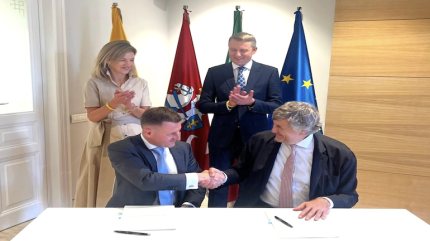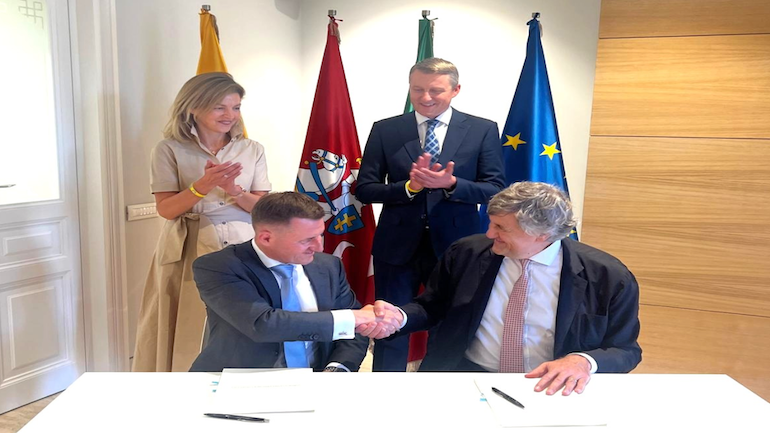
Signing of the MOU by Ignalina Nuclear Power Plant Director General Linas Baužys and Newcleo Director General Stefano Buono (Photo credit: Ignalina Nuclear Power Plant)
France-based nuclear start-up newcleo has signed a memorandum of understanding (MOU) with Ignalina Nuclear Power Plant (INPP), which envisages close cooperation in the analysis of the feasibility of the advanced fast reactor technology in Lithuania. The agreement will encourage the implementation of new pilot projects related to nuclear energy in Lithuania, according to Minister of Energy Žygimantas Vaičiūnas.
“The Ignalina Nuclear Power Plant has been a strategic pillar of Lithuania’s energy system for many years, together with the high level of expertise of nuclear power specialists, which is now being used only for INPP closure activities,” he said. “Our aim is not only to preserve this expertise, but also to use it for the development of advanced nuclear technologies. Although the implementation of such projects is not rapid, we should not miss the opportunity to assess the potential of such technologies to further reduce the volume of used nuclear fuel in the future, and this agreement allows us to start assessing innovative solutions now.”
INPP Director General Linas Baužys noted: “We have nuclear energy expertise that we can and must use as we move into a new energy phase. This agreement opens up opportunities to assess how our existing expertise and infrastructure can be applied to innovative solutions, both in the field of power generation and used nuclear fuel management. Cooperating with international partners such as newcleo, we will look for sustainable solutions to advance Lithuania’s energy sector.”
Earlier in July, the Lithuanian Government discussed the possibility of developing nuclear energy and has agreed to establish a working group at the Ministry of Energy. This will involve INPP in preparing development options while the State Nuclear Power Safety Inspectorate was tasked with submitting proposals on safety regulations.
INPP comprised two Soviet-supplied water-cooled graphite-moderated channel-type RBMK-1500 reactors. Unit 1 came online in 1983 and unit 2 in 1987. Following the Chornobyl accident, both units were de-rated to 1360 MWe. Lithuania agreed to close the plant as part of its accession agreement to the European Union (EU). Ignalina 1 closed in 2004 and Ignalina 2 in 2009 after which Lithuania became an energy importer. The past few years has seen INPP focusing on defueling the reactors, which are expected to be fully decommissioned by 2038. The work is mostly funded by the EU through the European Bank for Reconstruction & Development (EBRD) and other funds.
According to newcleo CEO Stefano Buono, the agreement “will contribute to sustainable solutions for radioactive waste management and energy security in Europe”. He added: “I am pleased that Lithuania, with its strong nuclear roots, is open to new nuclear energy perspectives.”
Newcleo’s LFR-AS-200 reactor design is based on an advanced lead-cooled fast reactor solution that allows the use of used nuclear fuel for reactor operation, which can provide an alternative to sustainable radioactive waste management. However, it is still in the conceptual design stage, despite an ever-growing number of agreements and partnerships the company enters into.
Newcleo says the MOU with Lithuania “sets the scene for feasibility studies to be carried out on areas including siting evaluations, reprocessing of Lithuania’s stocks of spent nuclear fuel, potential industrial applications in connection to hydrogen, ammonia production, and the creation of local nuclear supply chains”. The project “also aims to evaluate the feasibility of integrating small modular reactors (SMRs), such as newcleo’s design, into an energy system prioritising renewables – the aim being to enhance grid stability while contributing to the broader objective of decarbonisation”.
In June, newcleo formed a joint venture with JAVYS, the Slovak state-owned Nuclear and Decommissioning Company to develop a project to build four LFR-AS-200 reactors at the Slovakian Jaslovské Bohunice site, to be powered with mixed oxide fuel fabricated from existing Slovakian used nuclear fuel. Newcleo says it “is seeking to expand this operating model to other territories with existing nuclear operations or legacy spent fuel, which include many Eastern European countries, as a way of sustainably managing waste while promoting energy independence”.
Since 2021, newcleo has raised over €570m ($666m) from institutional and individual investors and has seen an increasing number of European players joining newcleo’s growing funding base, which to date counts over 750 shareholders.
While newcleo’s website extol the virtues of the LFR, there is scant detail of the nuclear technology that will power the reactor, although there appears to be some progress on non-nuclear components of the design. Currently, the only operating liquid metal-cooled fast reactors are in Russia, using sodium as the coolant. Russia is also constructing the world’s first ever lead-cooled SMR (Brest-OD-300). This reactor is based on decades of complex research and development supported by the entire Russian nuclear industry. It is due to begin operation in 2029. By contrast, newcleo’s LFR remains at the very early conceptual design stage.

